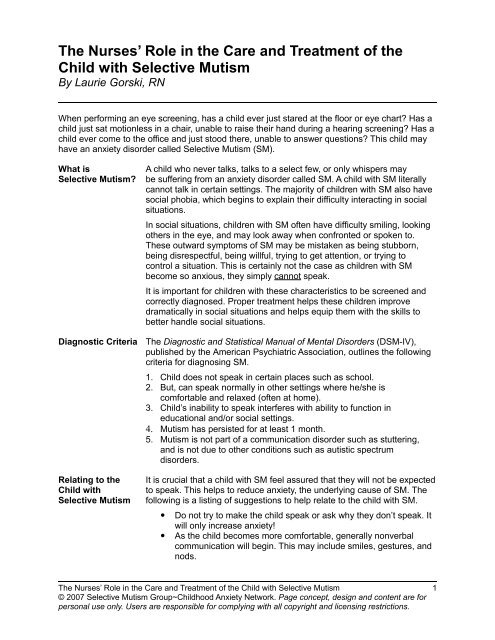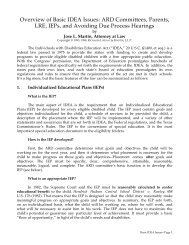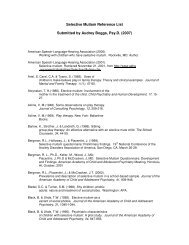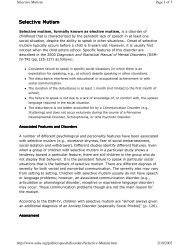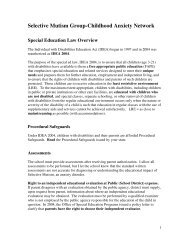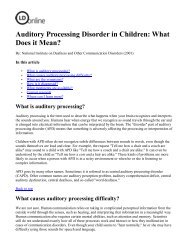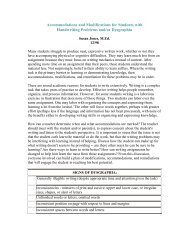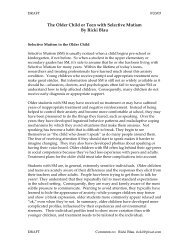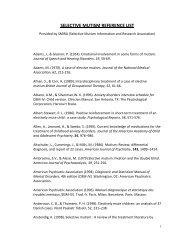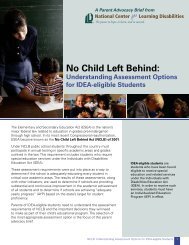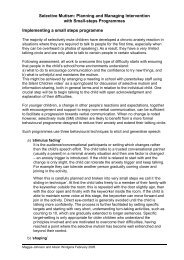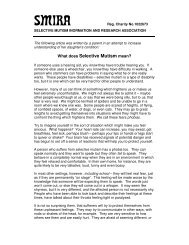The Nurses’ Role in the Care and Treatment of the Child with Selective Mutism
Nurses Role - Selective Mutism Group
Nurses Role - Selective Mutism Group
- No tags were found...
You also want an ePaper? Increase the reach of your titles
YUMPU automatically turns print PDFs into web optimized ePapers that Google loves.
<strong>The</strong> <strong>Nurses’</strong> <strong>Role</strong> <strong>in</strong> <strong>the</strong> <strong>Care</strong> <strong>and</strong> <strong>Treatment</strong> <strong>of</strong> <strong>the</strong><strong>Child</strong> <strong>with</strong> <strong>Selective</strong> <strong>Mutism</strong>By Laurie Gorski, RNWhen perform<strong>in</strong>g an eye screen<strong>in</strong>g, has a child ever just stared at <strong>the</strong> floor or eye chart? Has achild just sat motionless <strong>in</strong> a chair, unable to raise <strong>the</strong>ir h<strong>and</strong> dur<strong>in</strong>g a hear<strong>in</strong>g screen<strong>in</strong>g? Has achild ever come to <strong>the</strong> <strong>of</strong>fice <strong>and</strong> just stood <strong>the</strong>re, unable to answer questions? This child mayhave an anxiety disorder called <strong>Selective</strong> <strong>Mutism</strong> (SM).What is<strong>Selective</strong> <strong>Mutism</strong>?Diagnostic CriteriaRelat<strong>in</strong>g to <strong>the</strong><strong>Child</strong> <strong>with</strong><strong>Selective</strong> <strong>Mutism</strong>A child who never talks, talks to a select few, or only whispers maybe suffer<strong>in</strong>g from an anxiety disorder called SM. A child <strong>with</strong> SM literallycannot talk <strong>in</strong> certa<strong>in</strong> sett<strong>in</strong>gs. <strong>The</strong> majority <strong>of</strong> children <strong>with</strong> SM also havesocial phobia, which beg<strong>in</strong>s to expla<strong>in</strong> <strong>the</strong>ir difficulty <strong>in</strong>teract<strong>in</strong>g <strong>in</strong> socialsituations.In social situations, children <strong>with</strong> SM <strong>of</strong>ten have difficulty smil<strong>in</strong>g, look<strong>in</strong>go<strong>the</strong>rs <strong>in</strong> <strong>the</strong> eye, <strong>and</strong> may look away when confronted or spoken to.<strong>The</strong>se outward symptoms <strong>of</strong> SM may be mistaken as be<strong>in</strong>g stubborn,be<strong>in</strong>g disrespectful, be<strong>in</strong>g willful, try<strong>in</strong>g to get attention, or try<strong>in</strong>g tocontrol a situation. This is certa<strong>in</strong>ly not <strong>the</strong> case as children <strong>with</strong> SMbecome so anxious, <strong>the</strong>y simply cannot speak.It is important for children <strong>with</strong> <strong>the</strong>se characteristics to be screened <strong>and</strong>correctly diagnosed. Proper treatment helps <strong>the</strong>se children improvedramatically <strong>in</strong> social situations <strong>and</strong> helps equip <strong>the</strong>m <strong>with</strong> <strong>the</strong> skills tobetter h<strong>and</strong>le social situations.<strong>The</strong> Diagnostic <strong>and</strong> Statistical Manual <strong>of</strong> Mental Disorders (DSM-IV),published by <strong>the</strong> American Psychiatric Association, outl<strong>in</strong>es <strong>the</strong> follow<strong>in</strong>gcriteria for diagnos<strong>in</strong>g SM.1. <strong>Child</strong> does not speak <strong>in</strong> certa<strong>in</strong> places such as school.2. But, can speak normally <strong>in</strong> o<strong>the</strong>r sett<strong>in</strong>gs where he/she iscomfortable <strong>and</strong> relaxed (<strong>of</strong>ten at home).3. <strong>Child</strong>’s <strong>in</strong>ability to speak <strong>in</strong>terferes <strong>with</strong> ability to function <strong>in</strong>educational <strong>and</strong>/or social sett<strong>in</strong>gs.4. <strong>Mutism</strong> has persisted for at least 1 month.5. <strong>Mutism</strong> is not part <strong>of</strong> a communication disorder such as stutter<strong>in</strong>g,<strong>and</strong> is not due to o<strong>the</strong>r conditions such as autistic spectrumdisorders.It is crucial that a child <strong>with</strong> SM feel assured that <strong>the</strong>y will not be expectedto speak. This helps to reduce anxiety, <strong>the</strong> underly<strong>in</strong>g cause <strong>of</strong> SM. <strong>The</strong>follow<strong>in</strong>g is a list<strong>in</strong>g <strong>of</strong> suggestions to help relate to <strong>the</strong> child <strong>with</strong> SM.Do not try to make <strong>the</strong> child speak or ask why <strong>the</strong>y don’t speak. Itwill only <strong>in</strong>crease anxiety!As <strong>the</strong> child becomes more comfortable, generally nonverbalcommunication will beg<strong>in</strong>. This may <strong>in</strong>clude smiles, gestures, <strong>and</strong>nods.<strong>The</strong> <strong>Nurses’</strong> <strong>Role</strong> <strong>in</strong> <strong>the</strong> <strong>Care</strong> <strong>and</strong> <strong>Treatment</strong> <strong>of</strong> <strong>the</strong> <strong>Child</strong> <strong>with</strong> <strong>Selective</strong> <strong>Mutism</strong> 1© 2007 <strong>Selective</strong> <strong>Mutism</strong> Group~<strong>Child</strong>hood Anxiety Network. Page concept, design <strong>and</strong> content are forpersonal use only. Users are responsible for comply<strong>in</strong>g <strong>with</strong> all copyright <strong>and</strong> licens<strong>in</strong>g restrictions.
Get down to <strong>the</strong> child’s level. Talk to <strong>the</strong> child normally, but don’texpect a response right away.M<strong>in</strong>imize eye contact <strong>and</strong> direct question<strong>in</strong>g <strong>and</strong> phrase questionsso <strong>the</strong> child can respond nonverbally. For example, <strong>in</strong>stead <strong>of</strong>“How are you do<strong>in</strong>g today?” say, “Are you hav<strong>in</strong>g a good daytoday?” That allows for a nod or a thumbs up, (a nonverbalresponse ra<strong>the</strong>r than a suggestion that a verbal response isrequired).F<strong>in</strong>d out someth<strong>in</strong>g that really <strong>in</strong>terests him or her.Do not act “surprised” or make a big deal if <strong>the</strong> child beg<strong>in</strong>s tospeak. This may embarrass <strong>the</strong>m <strong>and</strong> cause a setback.Sometimes be<strong>in</strong>g silly <strong>and</strong> tak<strong>in</strong>g <strong>the</strong> pressure <strong>of</strong>f a potentiallystressful situation for <strong>the</strong> child helps. Use a puppet or stuffedanimal. Give <strong>the</strong>m alternatives to speak<strong>in</strong>g. Let <strong>the</strong>m po<strong>in</strong>t, snap,or raise <strong>the</strong>ir h<strong>and</strong>. Chances are <strong>the</strong>y know <strong>the</strong> answer, but justcan’t get <strong>the</strong> words out!<strong>The</strong>re is Help<strong>The</strong> <strong>Selective</strong> <strong>Mutism</strong> Group-<strong>Child</strong>hood Anxiety Network (SMG~CAN) is agroup <strong>of</strong> people dedicated to <strong>the</strong> research <strong>of</strong> SM <strong>and</strong> <strong>of</strong>fers support <strong>and</strong><strong>in</strong>formation to parents <strong>and</strong> o<strong>the</strong>rs who work <strong>with</strong> children <strong>with</strong> SM. If youth<strong>in</strong>k you know a child who may have SM, please contact <strong>the</strong> SMG-CANfor more <strong>in</strong>formation. Visit www.selectivemutism.org.<strong>The</strong> SMG~CAN is a division <strong>of</strong> <strong>the</strong> nonpr<strong>of</strong>it, 501(c) 3 organization, <strong>the</strong><strong>Child</strong>hood Anxiety Network www.childhoodanxietynetwork.org.<strong>The</strong> <strong>Nurses’</strong> <strong>Role</strong> <strong>in</strong> <strong>the</strong> <strong>Care</strong> <strong>and</strong> <strong>Treatment</strong> <strong>of</strong> <strong>the</strong> <strong>Child</strong> <strong>with</strong> <strong>Selective</strong> <strong>Mutism</strong> 2© 2007 <strong>Selective</strong> <strong>Mutism</strong> Group~<strong>Child</strong>hood Anxiety Network. Page concept, design <strong>and</strong> content are forpersonal use only. Users are responsible for comply<strong>in</strong>g <strong>with</strong> all copyright <strong>and</strong> licens<strong>in</strong>g restrictions.


